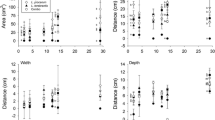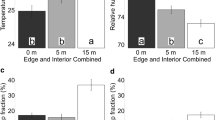Abstract
Surprisingly little research has been conducted to investigate interactions between subterranean termites and bark beetles. Facilitative interactions between these organisms could easily alter stand dynamics and impact wood utilization strategies. A series of American Wood Protection Association Standard E1-09 “choice tests” were carried out to determine the feeding preference of Reticulitermes flavipes Kollar (Isoptera: Rhinotermitidae) for blue-stained sapwood and sapwood impregnated with various bark beetle pheromones. Reticulitermes flavipes exhibited a feeding preference for both air-dried and kiln-dried blue-stained sapwood, unstained sapwood treated with frontalin, and air-dried blue-stained sapwood treated with a 0.02% solution of both frontalin and endo-brevicomin. The implications of these results are far reaching, with particular relevance to forest health, ecology, and utilization.
Similar content being viewed by others
References
Adams L, Boopathy R (2005) Isolation and characterization of enteric bacteria from the hindgut of Formosan termite. Bioresource Technol 96:1592–1598
American Wood Protection Association (2009) AWPA book of standards. Birmingham, AL
Ballard RG, Walsh MA, Cole WE (1983) The penetration and growth of blue-stain fungi in the sapwood of lodgepole pine attacked by mountain pine beetle. Can J Bot 62:1724–1729
Barras SJ (1970) Antagonism between Dendroctonus frontalis and the fungus Ceratocystis minor. Ann Entomol Soc Am 63:1187–1190
Barron EH (1971) Deterioration of southern pine beetle-killed trees. Forest Prod J 21:57–60
Basham HG (1970) Wilt of loblolly pine inoculated with blue-stain fungi of the genus Ceratocystis. Phytopathology 60:750–754
Bramble WC, Holst EC (1940) Fungi associated with Dendroctonus in killing shortleaf pines and their effect on conduction. Phytopathology 30:881–899
Caird RW (1935) Physiology of pines infested with bark beetles. Bot Gaz 96:709–733
Cornelius ML, Daigle DJ, Connick WJ Jr, Parker A, Wunch K (2002) Responses of Coptotermes formosanus and Reticulitermes flavipes (Isoptera: Rhinotermitidae) to three types of wood rot fungi cultured on different substrates. J Econ Entomol 95:121–128
Coulson RN (1979) Population dynamics of bark beetles. Annu Rev Entomol 24:417–447
Curtis AD, Waller DA (1997) Variation in rates of nitrogen fixation in termites: response to dietary nitrogen in the field and laboratory. Physiol Entomol 22:303–309
Franklin RT (1970) Observations on the blue stain-southern pine beetle relationship. J GA Entomol Soc 5:53–57
Garnier-Sallam E, Grech I, Czaninski Y, Tollier TM, Monties B (1992) Cytochemical ultrastructure study of lignin degradation of parietal residues of spruce and poplar wood by Reticulitermes lucifugus var. santonensis (Rhinotermitidae, Isoptera). Can J Bot 70:933–941
Happ GM, Happ CM, Barras SJ (1971) Fine structure of the prothoracic mycangium, a chamber for the culture of symbiotic fungi in the southern pine beetle, Dendroctonus frontalis. Tissue Cell 3:295–308
Humar M, Vek V, Bucar B (2008) Properties of blue-stained wood. Wood Industry 59:75–79
Inta R, Evans TA, Lai JCS (2009) Effect of vibratory alarm signals on the foraging behavior of subterranean termites (Isoptera: Rhinotermitidae). J Econ Entomol 102:121–126
JMP (1989–2008) Version 8. SAS Institute Inc., Cary, NC
Kelly MW, Barefoot JE, Swint WH, Levi MP (1982) Properties of particle- and hardboard made from healthy and beetle-killed southern pine. Forest Prod J 32:33–39
Klepzig KD, Raffa KF, Smalley EB (1991) Association of an insect-fungal complex with red pine decline in Wisconsin. Forest Sci 37:1119–1139
Klepzig KD, Moser JC, Lombardero FJ, Hofstetter RW, Ayres MP (2001) Symbiosis and competition: complex interactions among beetles, fungi, and mites. Symbiosis 30:83–96
La Fage JP (1987) Practical considerations of the Formosan subterranean termite in Louisiana: a 30-year-old problem, pp. 37–42. In: Tamashiro M, Su NY (eds) Biology and control of the Formosan subterranean termite. Research and Extension series 083. College of Tropical Agriculture and Human Resources, University of Hawaii, Honolulu
Levi MP, Dietrich RL (1976) Utilization of southern pine beetle-killed timber. Forest Prod J 26:42–47
Levia DF, Frost EE (2006) Variability of throughfall volume and solute inputs in wooden ecosystems. Prog Phys Geog 30:605–632
Londo AJ (2010) The southern pine beetle: cost sharing pine thinning operations for southern pine beetle prevention in north Mississippi. Tree Talk Winter 2010
Mathre DE (1964) Pathogenicity of Ceratocystis ips and Ceratocystis minor to Pinus ponderosa. Contrib Boyce Thompson Inst 22:363–388
McMichael JA (1998) Survey of subterranean termites (Isoptera: Rhinotermitidae) in trees in Sam Houston Jones State Park, West Lake, Lousiana. M.S. thesis, Lousiana State University, Shreveport, LA
Nebeker TE, Hodges JD, Blanche CA (1993) Host response to bark beetle and pathogen colonization. In: Schowalter TD, Filip GM (eds) Beetle-pathogen interactions in Conifer forests. Academic, London, pp 157–173
Nelson RM (1934) Effect of blue-stain fungi on southern pine attacked by bark beetles. Phytopathology 7:327–353
Pandey S, Waller DA, Gordon AS (1992) Variation in acetylene-reduction (nitrogen-fixation) rates in Reticulitermes spp. (Isoptera:Rhinotermitidae). Va J Sci 43:333–338
Reinhard J, Kaib M (2000) Trail communication during foraging and recruitment in the subterranean termite Reticulitermes santonensis De Feytaud (Isoptera, Rhinotermitidae. J Insect Behav 14:157–171
Schowalter TD (1981) Insect herbivore relationship to the state of the host plant: biotic regulation of ecosystem nutrient cycling through ecological succession. Oikos 37:126–130
Smith MT, Salmon SM, Payne TL (1993) The southern pine bark beetle guild: a historic review of the research on the semiochemical-based communication system of the five principal species. Virginia Agricultural Experiment Station Bulletin 93–4. Virginia Agricultural Experiment Station, Blacksburg, VA
Su N-Y, Bardunias P (2005) Foraging behavior of subterranean termites (Isoptera: Rhinotermitidae): food discovery and movement of termites within established galleries, pp. 443–445. In Proceedings, 5th International Conference on Urban Pests 10–13 July 2005, Singapore
Su N-Y, Tamashiro M, Yates JR, Haverty MI (1984) Foraging behavior of the Formosan subterranean termite (Isoptera: Rhinotermitidae). Environ Entomol 13:1466–1470
Sullivan BT, Shepherd WP, Pureswaran DS, Tashiro T, Mori K (2007) Evidence that (+)-endo-Brevicomin is a male-produced component of the southern pine beetle aggregation pheromone. J Chem Ecol 33:1510–1527
Thatcher RC, Searcy JL, Coster JE, Hertel GD (1980) The southern pine beetle. USDA, Expanded Southern Pine Beetle Research and Application Program, USDA Forest Service, Science and Education Administration, Pineville, LA. Tech Bull 1631:265
Tisdale RA, Nebeker TE, Hodges JD (2003) The role of oleoresin flow in the induced response of loblolly pine to a southern pine beetle associated fungus. Can J Bot 81:368–374
Waring RH, Franklin JF (1979) Evergreen coniferous forests of the Pacific Northwest. Science 204:1380–1386
Whitney HS (1971) Association of Dendroctonus ponderosae with blue-stain fungi and yeasts during brood development in lodgepole pine. Can Entomol 103:1495–1503
Yamada A, Inoue T, Wiwatwitaya D, Ohkuma M, Kudo T, Sugimoto A (2006) Nitrogen fixation by termites in tropical forests, Thailand. Ecosystems 9:75–83
Acknowledgements
This research was funded by the USDA Forest Service Forest Health Protection and Southern Research Station, and the Mississippi Forestry Commission. The authors would like to thank Southeastern Timber Products of Ackerman, MS, for donating the lumber for this project. This manuscript was approved for publication as journal article No. J-11958 of the Mississippi Agricultural and Forestry Experiment Station, Mississippi State University.
Author information
Authors and Affiliations
Corresponding author
Rights and permissions
About this article
Cite this article
Little, N.S., Riggins, J.J., Schultz, T.P. et al. Feeding Preference of Native Subterranean Termites (Isoptera: Rhinotermitidae: Reticulitermes) for Wood Containing Bark Beetle Pheromones and Blue-Stain Fungi. J Insect Behav 25, 197–206 (2012). https://doi.org/10.1007/s10905-011-9293-5
Revised:
Accepted:
Published:
Issue Date:
DOI: https://doi.org/10.1007/s10905-011-9293-5




